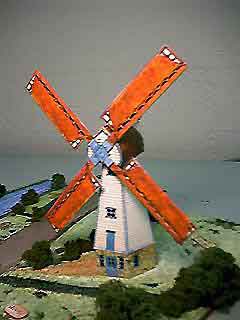
The Smock Mill
 The Fiddlersgreen downloadable Smock Mill |
The smock mill is a type of windmill that consists of a sloping, horizontally weatherboarded tower, usually with six or eight sides. It is topped with a roof This type of windmill got its name from its resemblance to smocks worn by farmers in an earlier period. Smock mills differ from tower mills, which are usually cylindrical rather than hexagonal or octagonal, and built from brick or stone instead of lumber. Most smock mills are octagonal and the remainder being mostly hexagonal in shape. |
||
|
|||
There is an operating smock mill on Nantucket Island, Massachusetts. Built in 1746 by Nathan Wilbur, a Nantucket sailor who The Old Mill was in deplorable condition when it was sold for twenty dollars in 1828 to Jared Gardner for use as "firewood." Instead of dismantling it, Gardner, a carpenter by trade, restored the mill to working condition making it capable once again of grinding corn. The mill was sold again in 1866 to John Francis Sylvia, a Portuguese miller of Azorean descent, who operated it for many years with his assistant Peter Hoy until it fell into disuse in 1892. In 1897, Miss Caroline French purchased the mill at an auction for $850 and donated it to the Nantucket Historical Association. The NHA restored it in 1937 and continues to maintain it, grind corn and guide tours of the mill during the summer and early autumn. |
|||
Smock Mills
Smock mills differ from tower mills, which are usually cylindrical rather than hexagonal or octagonal, and built from brick, stone or masonry instead of timber. The majority of smock mills are octagonal in plan, with a lesser number hexagonal in plan, such as Killick's Mill, Meopham. A very small number of smock mills were decagonal or dodecagonal in plan, an example of the latter being at Wicken, Cambridgeshire.
Smock mills exist in Western Europe and particularly in England, where they were common, particularly in the county of Kent, where the tallest surviving smock mill in the United Kingdom, Union Mill, can be found at Cranbrook. They reached their heyday in the earlier part of the 19th century, after which the advent of steam power started the decline of the windmill.



 cap that rotates to bring the sails into the wind. The fantail goes to the rear of the cap and is cleverly used to automatically keep the blades into the wind.
cap that rotates to bring the sails into the wind. The fantail goes to the rear of the cap and is cleverly used to automatically keep the blades into the wind.

 had spent time in Holland, the "Old Mill" is the oldest functioning mill in the United States. It is the only surviving mill of the four smock mills that once stood on Popsquachet (windy hill in the Native American language of the Wampanoags) overlooking Nantucket town. Until late in the 19th century, there was a fifth Nantucket mill called "Round-Top Mill" on the site of the present New North Cemetery.
had spent time in Holland, the "Old Mill" is the oldest functioning mill in the United States. It is the only surviving mill of the four smock mills that once stood on Popsquachet (windy hill in the Native American language of the Wampanoags) overlooking Nantucket town. Until late in the 19th century, there was a fifth Nantucket mill called "Round-Top Mill" on the site of the present New North Cemetery.